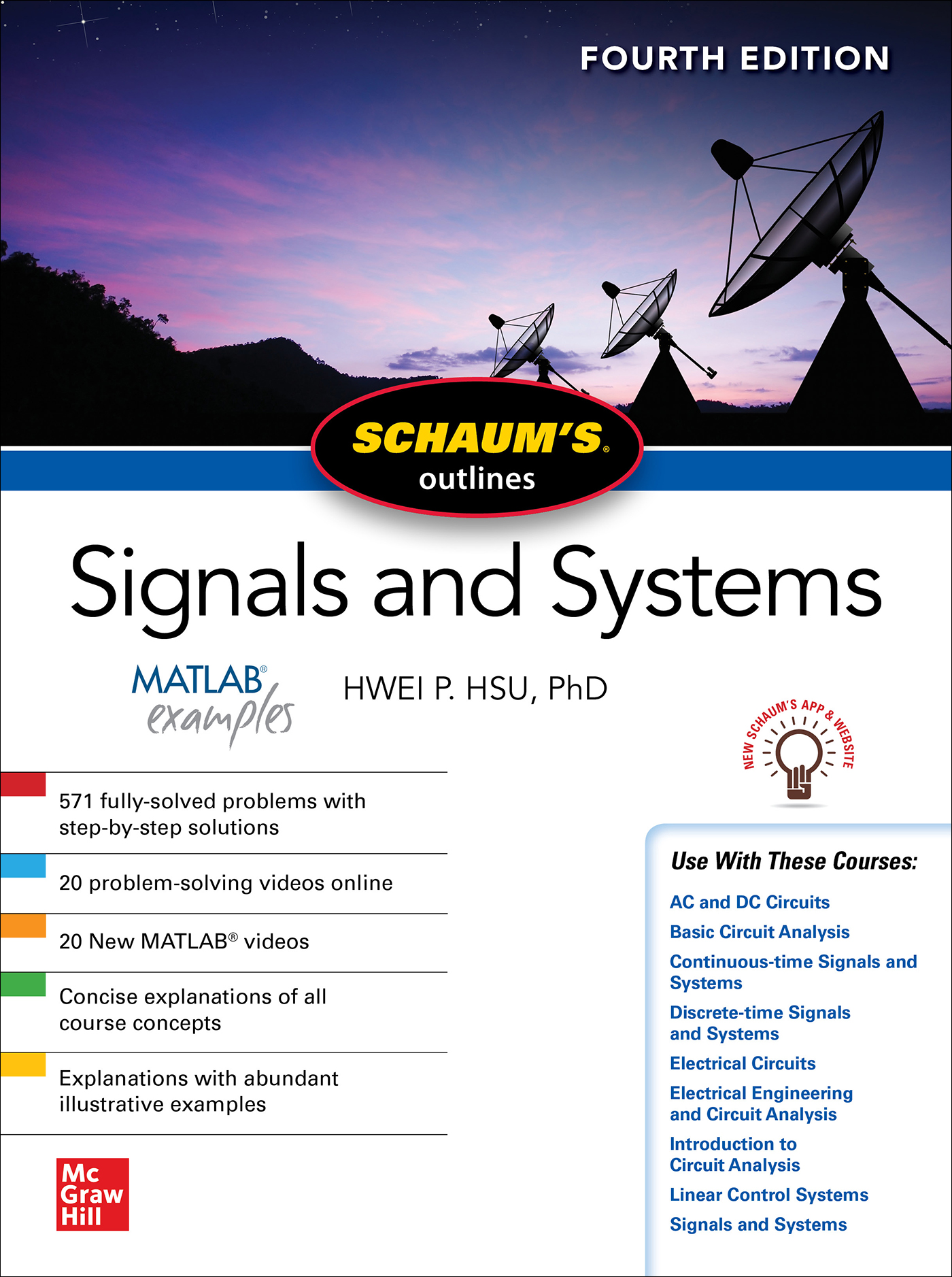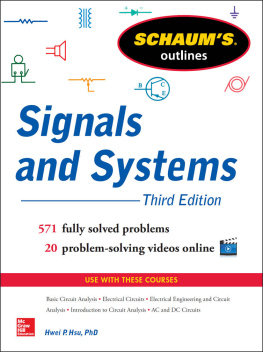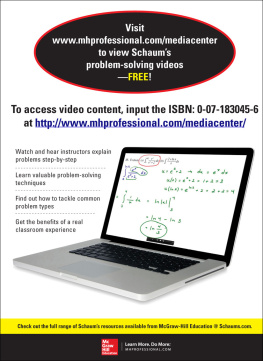Contents
Guide
Page List

 HWEI P. HSU
HWEI P. HSU received his BS from National Taiwan University and his MS and PhD from Case Institute of Technology. He has published several books, including
Schaums Outline of Analog and Digital Communications and Schaums Outline of Probability, Random Variables, and Random Processes. Copyright 2020, 2014, 2011, 1995 by McGraw-Hill Education. All rights reserved. Except as permitted under the United States Copyright Act of 1976, no part of this publication may be reproduced or distributed in any form or by any means, or stored in a database or retrieval system, without the prior written permission of the publisher.
ISBN: 978-1-26-045425-3
MHID: 1-26-045425-8 The material in this eBook also appears in the print version of this title: ISBN: 978-1-26-045424-6, MHID: 1-26-045424-X. eBook conversion by codeMantra
Version 1.0 All trademarks are trademarks of their respective owners. Rather than put a trademark symbol after every occurrence of a trademarked name, we use names in an editorial fashion only, and to the benefit of the trademark owner, with no intention of infringement of the trademark. Where such designations appear in this book, they have been printed with initial caps. McGraw-Hill Education eBooks are available at special quantity discounts to use as premiums and sales promotions or for use in corporate training programs. To contact a representative, please visit the Contact Us page at www.mhprofessional.com.
McGraw-Hill Education, the McGraw-Hill Education logo, Schaums, and related trade dress are trademarks or registered trademarks of McGraw-Hill Education and/or its affiliates in the United States and other countries, and may not be used without written permission. All other trademarks are the property of their respective owners. McGraw-Hill Education is not associated with any product or vendor mentioned in this book. TERMS OF USE This is a copyrighted work and McGraw-Hill Education and its licensors reserve all rights in and to the work. Use of this work is subject to these terms. Except as permitted under the Copyright Act of 1976 and the right to store and retrieve one copy of the work, you may not decompile, disassemble, reverse engineer, reproduce, modify, create derivative works based upon, transmit, distribute, disseminate, sell, publish or sublicense the work or any part of it without McGraw-Hill Educations prior consent.
You may use the work for your own noncommercial and personal use; any other use of the work is strictly prohibited. Your right to use the work may be terminated if you fail to comply with these terms. THE WORK IS PROVIDED AS IS. McGRAW-HILL EDUCATION AND ITS LICENSORS MAKE NO GUARANTEES OR WARRANTIES AS TO THE ACCURACY, ADEQUACY OR COMPLETENESS OF OR RESULTS TO BE OBTAINED FROM USING THE WORK, INCLUDING ANY INFORMATION THAT CAN BE ACCESSED THROUGH THE WORK VIA HYPERLINK OR OTHERWISE, AND EXPRESSLY DISCLAIM ANY WARRANTY, EXPRESS OR IMPLIED, INCLUDING BUT NOT LIMITED TO IMPLIED WARRANTIES OF MERCHANTABILITY OR FITNESS FOR A PARTICULAR PURPOSE. McGraw-Hill Education and its licensors do not warrant or guarantee that the functions contained in the work will meet your requirements or that its operation will be uninterrupted or error free. Neither McGraw-Hill Education nor its licensors shall be liable to you or anyone else for any inaccuracy, error or omission, regardless of cause, in the work or for any damages resulting therefrom.
McGraw-Hill Education has no responsibility for the content of any information accessed through the work. Under no circumstances shall McGraw-Hill Education and/or its licensors be liable for any indirect, incidental, special, punitive, consequential or similar damages that result from the use of or inability to use the work, even if any of them has been advised of the possibility of such damages. This limitation of liability shall apply to any claim or cause whatsoever whether such claim or cause arises in contract, tort or otherwise.
Preface to The Second Edition
The purpose of this book, like its previous edition, is to provide the concepts and theory of signals and systems needed in almost all electrical engineering fields and in many other engineering and science disciplines as well. In the previous edition the book focused strictly on deterministic signals and systems. This new edition expands the contents of the first edition by adding two chapters dealing with random signals and the response of linear systems to random inputs.
The background material on probability needed for these two chapters is included in . I wish to express my appreciation to Ms. Kimberly Eaton and Mr. Charles Wall of the McGraw-Hill Schaum Series for inviting me to revise the book. HWEI P. HSU
Shannondell at Valley Forge, Audubon, Pennsylvania
Preface to The First Edition
The concepts and theory of signals and systems are needed in almost all electrical engineering fields and in many other engineering and scientific disciplines as well.
They form the foundation for further studies in areas such as communication, signal processing, and control systems. This book is intended to be used as a supplement to all textbooks on signals and systems or for self-study. It may also be used as a textbook in its own right. Each topic is introduced in a chapter with numerous solved problems. The solved problems constitute an integral part of the text. .
I am grateful to Professor Gordon Silverman of Manhattan College for his assistance, comments, and careful review of the manuscript. I also wish to thank the staff of the McGraw-Hill Schaum Series, especially John Aliano for his helpful comments and suggestions and Maureen Walker for her great care in preparing this book. Last, I am indebted to my wife, Daisy, whose understanding and constant support were necessary factors in the completion of this work. HWEI P. HSU
Montville, New Jersey
To the Student
To understand the material in this text, the reader is assumed to have a basic knowledge of calculus, along with some knowledge of differential equations and the first circuit course in electrical engineering. This text covers both continuous-time and discrete-time signals and systems.
If the course you are taking covers only continuous-time signals and systems, you may study parts of . To really master a subject, a continuous interplay between skills and knowledge must take place. By studying and reviewing many solved problems and seeing how each problem is approached and how it is solved, you can learn the skills of solving problems easily and increase your store of necessary knowledge. Then, to test and reinforce your learned skills, it is imperative that you work out the supplementary problems (hints and answers are provided). I would like to emphasize that there is no short cut to learning except by doing.
Contents
* The laptop icon next to an exercise indicates that the exercise is also available as a video with step-by-step instructions.
These videos are available on the website by following the instructions on the inside front cover.
CHAPTER 1
Signals and Systems
1.1 Introduction
The concept and theory of signals and systems are needed in almost all electrical engineering fields and in many other engineering and scientific disciplines as well. In this chapter we introduce the mathematical description and representation of signals and systems and their classifications. We also define several important basic signals essential to our studies.





 HWEI P. HSU received his BS from National Taiwan University and his MS and PhD from Case Institute of Technology. He has published several books, including Schaums Outline of Analog and Digital Communications and Schaums Outline of Probability, Random Variables, and Random Processes. Copyright 2020, 2014, 2011, 1995 by McGraw-Hill Education. All rights reserved. Except as permitted under the United States Copyright Act of 1976, no part of this publication may be reproduced or distributed in any form or by any means, or stored in a database or retrieval system, without the prior written permission of the publisher.
HWEI P. HSU received his BS from National Taiwan University and his MS and PhD from Case Institute of Technology. He has published several books, including Schaums Outline of Analog and Digital Communications and Schaums Outline of Probability, Random Variables, and Random Processes. Copyright 2020, 2014, 2011, 1995 by McGraw-Hill Education. All rights reserved. Except as permitted under the United States Copyright Act of 1976, no part of this publication may be reproduced or distributed in any form or by any means, or stored in a database or retrieval system, without the prior written permission of the publisher.